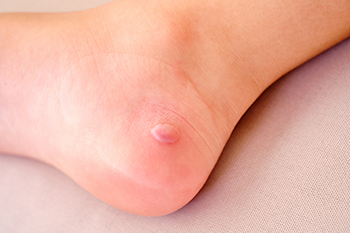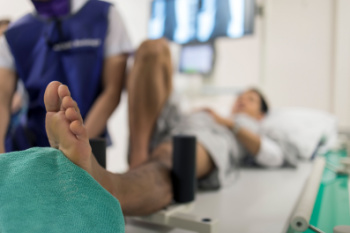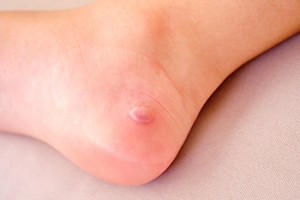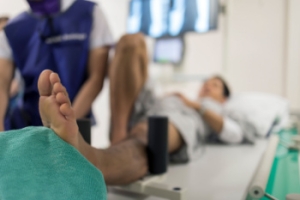
Symptoms of Plantar Fasciitis

Plantar fasciitis causes distinct symptoms centered on the sole of the foot, particularly near the heel and arch. Individuals often experience sharp pain or discomfort along the bottom of the foot, radiating from the heel toward the toes. The pain tends to be most intense during the initial steps after waking up or following prolonged periods of rest, known as post-static dyskinesia. Throughout the day, the pain may lessen with movement but can intensify after long periods of standing or walking. Some describe the pain from plantar fasciitis as a dull ache or burning sensation. The arch of the foot may also feel tender to the touch, especially near the heel where the plantar fascia attaches to the bone. If you are experiencing heel pain, it is strongly suggested that you make an appointment with a podiatrist sooner rather than later. This foot doctor can accurately diagnose plantar fasciitis and begin an effective relief and treatment plan.
Plantar fasciitis can be very painful and inconvenient. If you are experiencing heel pain or symptoms of plantar fasciitis, contact Dr. Mark Spier from Maryland. Our doctor can provide the care you need to keep you pain-free and on your feet.
What Is Plantar Fasciitis?
Plantar fasciitis is the inflammation of the thick band of tissue that runs along the bottom of your foot, known as the plantar fascia, and causes mild to severe heel pain.
What Causes Plantar Fasciitis?
- Excessive running
- Non-supportive shoes
- Overpronation
- Repeated stretching and tearing of the plantar fascia
How Can It Be Treated?
- Conservative measures – anti-inflammatories, ice packs, stretching exercises, physical therapy, orthotic devices
- Shockwave therapy – sound waves are sent to the affected area to facilitate healing and are usually used for chronic cases of plantar fasciitis
- Surgery – usually only used as a last resort when all else fails. The plantar fascia can be surgically detached from the heel
While very treatable, plantar fasciitis is definitely not something that should be ignored. Especially in severe cases, speaking to your doctor right away is highly recommended to avoid complications and severe heel pain. Your podiatrist can work with you to provide the appropriate treatment options tailored to your condition.
If you have any questions please feel free to contact one of our offices located in Columbia and Reisterstown, MD . We offer the newest diagnostic and treatment technologies for all your foot and ankle needs.
Plantar Fasciitis
The plantar fascia is a connective tissue in the heel that stretches across the bottom length of your foot. Plantar fasciitis occurs when the connective tissue becomes inflamed, causing heel pain and discomfort during physical activity. Although the condition is completely treatable, traditional methods can take up to a year to start becoming effective.
Plantar fasciitis is caused by a number of everyday activities, so understanding the condition is important for managing and treating it. One of the most common causes of plantar fasciitis is excessive running, especially with improper fitting or non-supportive shoes. Too much exercise can lead to the plantar fascia being overworked and overstretched, which can cause tears in the tissue. Along with improper fitting shoes, pronation, the rolling of the feet inward, is a common cause of plantar fasciitis. If not treated properly, the plantar fascia becomes overstretched and starts to tear, causing inflammation.
Despite the common causes of plantar fasciitis, there are many different treatment options. For less severe cases, conservative home remedies include taking anti-inflammatory drugs to alleviate pain, applying ice packs to the bottom of your foot and heel, slowly stretching and exercising your feet to re-strengthen the tissue, and using orthotic devices are all ways to help manage your plantar fasciitis.
For more severe cases, shockwave therapy has become a common solution for plantar fasciitis. Shockwave therapy can effectively break up the tissue on the bottom of your foot which facilitates healing and regeneration. This fights the chronic pain caused by plantar fasciitis. Even if this doesn’t work, surgery is always a final option. Surgery on the tissue itself can be done to permanently correct the issue and stop the inflammation and pain in your heels.
No matter what the case may be, consulting your podiatrist is the first and best step to recovery. Even the slightest amount of heel pain could be the first stage of plantar fasciitis. Untreated symptoms can lead to the tearing and overstretching of tissue. Because the tearing of tissue can be compounded if it remains ignored, it can evolve into a severe case. The solution is early detection and early treatment. Talk to your podiatrist about the possibilities of plantar fasciitis if you’re experiencing heel pain.
Caring for Blisters on the Foot

There are many causes for blisters, which are small sacs of fluid that form on the body. One of the main causes of blisters on the feet is new, tight, or ill-fitting shoes. The harder areas of the shoe can rub against your heels, soles, and toes, and if the motion is repeated for long periods, blisters often will form. These become very painful, especially if you continue the activity. Excessive moisture or perspiration, more often in warmer weather, also may cause blisters. There are a few precautions you can take to prevent blisters. Keeping the feet dry and putting powder on them to reduce sweating, and wearing moisture-wicking socks can help. Wearing softer, more flexible shoes can reduce the chances of blister formation, and reducing your activity for a few days will allow them to heal on their own. If a blister pops open, is extremely large, or won’t heal, it is suggested that you seek the professional care of a podiatrist who can safely drain the area and help reduce the chance of infection.
Blisters are prone to making everyday activities extremely uncomfortable. If your feet are hurting, contact Dr. Mark Spier of Maryland. Our doctor can provide the care you need to keep you pain-free and on your feet.
Foot Blisters
Foot blisters develop as a result of constantly wearing tight or ill-fitting footwear. This happens due to the constant rubbing from the shoe, which can often lead to pain.
What Are Foot Blisters?
A foot blister is a small fluid-filled pocket that forms on the upper-most layer of the skin. Blisters are filled with clear fluid and can lead to blood drainage or pus if the area becomes infected.
How Do Blisters Form?
Blisters on the feet are often the result of constant friction of skin and material, usually by shoe rubbing. Walking in sandals, boots, or shoes that don’t fit properly for long periods of time can result in a blister. Having consistent foot moisture and humidity can easily lead to blister formation.
Prevention & Treatment
It is important to properly care for the affected area in order to prevent infection and ease the pain. Do not lance the blister and use a Band-Aid to provide pain relief. Also, be sure to keep your feet dry and wear proper fitting shoes. If you see blood or pus in a blister, seek assistance from a podiatrist.
If you have any questions, please feel free to contact one of our offices located in Columbia and Reisterstown, MD . We offer the newest diagnostic and treatment technologies for all your foot care needs.
Blisters
Blisters are pockets of fluid that occur under the top layer of your skin. These fluid pockets are usually filled with pus, blood, or serum. Blisters may itch or hurt and can appear as a single bubble or in clusters.
The most common types of blisters are friction blisters. This type of blister may be caused by wearing shoes that are too tight. Friction blisters can also occur on the hands. A change in temperature may also cause blisters on the feet. In the freezing air, frostbite on your toes can lead to blisters, as well as sunburn from hot weather.
The best way to treat a blister is to keep it clean and dry. Most blisters will get better on their own. Once the skin absorbs the fluid within the blister, it will flatten and eventually peel off. You should avoid popping your blister unless you podiatrist does it for you. Additional treatment options include applying an ice pack to the blister or using over-the-counter blister bandages to cover the affected area.
If your blister becomes discolored, inflamed, or worsens it is advised that you speak to your podiatrist. Blisters that are yellow, green, or purple may be infected and require immediate medical attention. Blisters that are abnormally colored may be a sign of a more serious underlying health condition such as herpes.
Risk Factors for Foot Stress Fractures
 A hairline fracture, or stress fracture, is a small crack or severe bruise within a bone that is common among athletes that are involved in running and jumping. People with osteoporosis are also more prone to developing hairline fractures. These injuries typically result from overuse or repetitive stress, often worsened by inadequate healing time between activities. The bones in the foot are particularly susceptible to stress fractures due to their role in absorbing impact during physical activities. Within the foot, the second and third metatarsals are frequently affected, as well as the heel, ankle bones, and navicular bone. Symptoms primarily include pain that worsens with activity and subsides with rest, swelling, tenderness, and bruising. Factors that can increase the risk of developing a stress fracture include participation in high-impact sports, certain foot structures, and weakened bones due to conditions like osteoporosis. Previous fractures, nutritional deficiencies, and improper equipment or techniques are other risk factors. Diagnosing a stress fracture often involves a physical exam and may require imaging tests like MRIs or bone scans, as X-rays might not detect fractures. If ignored, a stress fracture can worsen into a complete break. If you are experiencing foot pain during exercise, it is suggested that you schedule an appointment with a podiatrist for an exam, diagnosis, and treatment options.
A hairline fracture, or stress fracture, is a small crack or severe bruise within a bone that is common among athletes that are involved in running and jumping. People with osteoporosis are also more prone to developing hairline fractures. These injuries typically result from overuse or repetitive stress, often worsened by inadequate healing time between activities. The bones in the foot are particularly susceptible to stress fractures due to their role in absorbing impact during physical activities. Within the foot, the second and third metatarsals are frequently affected, as well as the heel, ankle bones, and navicular bone. Symptoms primarily include pain that worsens with activity and subsides with rest, swelling, tenderness, and bruising. Factors that can increase the risk of developing a stress fracture include participation in high-impact sports, certain foot structures, and weakened bones due to conditions like osteoporosis. Previous fractures, nutritional deficiencies, and improper equipment or techniques are other risk factors. Diagnosing a stress fracture often involves a physical exam and may require imaging tests like MRIs or bone scans, as X-rays might not detect fractures. If ignored, a stress fracture can worsen into a complete break. If you are experiencing foot pain during exercise, it is suggested that you schedule an appointment with a podiatrist for an exam, diagnosis, and treatment options.
Activities where too much pressure is put on the feet can cause stress fractures. To learn more, contact Dr. Mark Spier from Maryland. Our doctor can provide the care you need to keep your pain free and on your feet.
Dealing with Stress Fractures of the Foot and Ankle
Stress fractures occur in the foot and ankle when muscles in these areas weaken from too much or too little use. The feet and ankles then lose support when walking or running from the impact of the ground. Since there is no protection, the bones receive the full impact of each step. Stress on the feet can cause cracks to form in the bones, thus creating stress fractures.
What Are Stress Fractures?
Stress fractures occur frequently in individuals whose daily activities cause great impact on the feet and ankles. Stress factors are most common among:
- Runners
- People affected with Osteoporosis
- Tennis or basketball players
- Gymnasts
- High impact workouts
Symptoms
Pain from the fractures occur in the area of the fractures and can be constant or intermittent. It will often cause sharp or dull pain with swelling and tenderness. Engaging in any kind of activity which involves high impact will aggravate pain.
If you have any questions please feel free to contact one of our offices located in Columbia and Reisterstown, MD . We offer the newest diagnostic and treatment technologies for all your foot and ankle needs.
Dealing with Stress Fractures of the Foot and Ankle
Stress fractures are small breaks in the bone that are caused by repetitive stress. They typically occur due to overuse, forcing the bones of the foot or ankle to continually absorb the full impact of each step taken. Stress fractures can also be caused by abnormal foot structure, osteoporosis, bone deformities, or wearing improper footwear during exercise.
Stress fractures are common for individuals whose daily activities cause high levels of impact on their feet and ankles. Those who run, play tennis or basketball, or practice gymnastics tend to experience these fractures more frequently. Anyone is susceptible to this problem, though. Individuals who are normally sedentary and suddenly begin an intense, high impact workout may sustain stress fractures. This is because their muscles are not yet strong enough to handle and cushion the intensity of their activity. Osteoporosis may also cause someone to get stress fractures, because the disease weakens an afflicted person's bones and makes it easier for them to break down.
Pain from stress fractures typically occurs in the general area of the fracture. Pain can also manifest as “pinpoint pain” or pain that is felt when the site of the injury is touched, and can be accompanied by swelling. It may occur during or after activity, and it may disappear while resting and return when standing or moving. Engaging in any kind of activity, high impact or otherwise, will aggravate the pain. If the intensity of the activity increases before the stress fracture has properly healed, it can cause a full fracture.
Treatment can vary depending on the individual and the degree of injury. The primary way to treat a stress fracture is to rest the hurt foot. Some fractures will heal quickly with only a little bit of rest, while others may require a long rest period and the use of crutches, immobilization, or physical therapy. Under certain circumstances, surgery may be required to install support pins around the fracture to assist in healing.
If you are undergoing a new exercise regimen in running or some other kind of high impact activity, set incremental goals on a weekly basis so you can build up muscle strength. Make sure to wear supportive shoes to better protect you feet.
If you begin to experience any symptoms of stress fractures, you should stop exercising and rest. If the symptoms persist, consult with your podiatrist. Remembering these tips can help you prevent stress fractures to your foot and ankle, and allow you to continue living normally.
Cause of Pain on Top of the Foot

Experiencing pain on the top of the foot is a common issue among runners and active individuals. One cause of this discomfort is extensor tendonitis, an inflammation of the extensor tendons responsible for lifting and straightening the toes. These tendons are vulnerable to injury because they lack protection from bones, muscles, or fatty tissue. Factors that place undue stress on the tendons include tight calf muscles, overtraining without adequate rest, and wearing improperly fitting shoes. Symptoms of extensor tendonitis include pain on the top of the foot during movement, swelling, and sometimes a visible bump along the tendon. Adjusting the way you lace your shoes can help to alleviate pressure on the top of the foot. If pain persists, it may indicate conditions, such as metatarsal stress fractures, atypical gout, or degenerative arthritis. Proper diagnosis from a podiatrist can address the root cause of the pain. If you are experiencing pain on top of the foot, it is suggested that you schedule an appointment with a podiatrist for an exam and treatment options.
Foot Pain
Foot pain can be extremely painful and debilitating. If you have a foot pain, consult with Dr. Mark Spier from Maryland. Our doctor will assess your condition and provide you with quality foot and ankle treatment.
Causes
Foot pain is a very broad condition that could be caused by one or more ailments. The most common include:
- Bunions
- Hammertoes
- Plantar Fasciitis
- Bone Spurs
- Corns
- Tarsal Tunnel Syndrome
- Ingrown Toenails
- Arthritis (such as Gout, Rheumatoid, and Osteoarthritis)
- Flat Feet
- Injury (from stress fractures, broken toe, foot, ankle, Achilles tendon ruptures, and sprains)
- And more
Diagnosis
To figure out the cause of foot pain, podiatrists utilize several different methods. This can range from simple visual inspections and sensation tests to X-rays and MRI scans. Prior medical history, family medical history, and any recent physical traumatic events will all be taken into consideration for a proper diagnosis.
Treatment
Treatment depends upon the cause of the foot pain. Whether it is resting, staying off the foot, or having surgery; podiatrists have a number of treatment options available for foot pain.
If you have any questions, please feel free to contact one of our offices located in Columbia and Reisterstown, MD . We offer the newest diagnostic and treatment technologies for all your foot care needs.



















